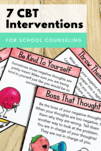As a school counselor or psychologist, it is necessary to have activities that are ready to go that can be used in individual counseling for a variety of referral reasons. Luckily, CBT activities are an excellent fit for school counselors looking for practical approaches. Here are 7 of my go-to CBT strategies to use in counseling.
1. Think-Feel-Act Triangle
The Think-Feel-Act Triangle is a classic CBT activity that you can use repeatedly. It is a simple visual that helps students break apart their thoughts, feelings, and behaviors and begin to see how those are connected.
When using it, have the student write down a difficult situation in the center of the triangle. At each corner of the triangle, write down what the student thought, felt, and how they acted.
To show them how these three elements are connected, change one and talk about how that might change the others. For example, if you change a negative thought to one that is more realistic, you may then feel different, and then you may act differently.
2. Feelings Thermometers
Feelings thermometers are great for helping students begin to understand the following concepts:
- Feelings vary in intensity.
- Our feelings effect how we react.
- Our reactions shouldn’t be stronger than our feelings.
- Sometimes we need help to handle strong feelings.
- We can use strategies to handle strong feelings.
Add language to the sides of the thermometer to help students better understand (i.e., Big problem, medium problem, small problem, and no problem).
3. CBT Activity: Reframing
Reframing is perfect when you are working with students who are prone to thinking mistakes. First, have them write down the negative thoughts and associated feelings and actions. Then, have them come up with 2-3 alternative thoughts. You can also come up with evidence to support these alternative thoughts and discuss how you would feel if you thought these instead.
A simple way to come up with an alternative thought is the Ugh, But strategy.
"Ugh, I didn't come in first in the race, but I improved my best time."
4. KICK Plans
One type of reframing is KICK plans, which are great when you are working with students who are anxious or worried. It gives them a step-by-step process to restructure their negative thinking.
- Knowing I’m Nervous: recognize that they are feeling nervous, worried, or some other negative emotion.
- Icky Thoughts: Identify the negative thoughts they are having that may be causing or influencing their feelings.
- Calm Thoughts: Identify an alternative thought that is more realistic or more positive.
- Keep Practicing: Practice identifying negative thoughts and finding alternatives.
5. Thought Records
Thought trackers are an excellent tool for students to begin to spot negative thoughts that they have. For example, students who struggle with anxiety may think negatively about themselves and why something happened. They may believe they aren't good enough or no one likes them.
Thought trackers will let you break those real examples down and also understand how the student perceives situations.
6. CBT Maps
A CBT Map is a more detailed and sequential version of the Think Feel Act map. Students can see how thoughts, feelings, and behaviors occur after a triggering event. Then, think about how the rules will affect the consequences of their actions. It is excellent for problem-solving with students after they make a poor choice to help them find an alternate path. You can also use the Problem - Choices - Consequences - Solutions Tool pictured below to problem solve.
Go through a situation and see where changes could be made.
7. Three Questions
When students make thinking mistakes, push them to find facts or evidence for what they believe. Thinking errors can affect how students feel and then how they act. Teaching them to stop and think to make sure their thoughts are true can be a helpful strategy for changing negative behaviors. Have them answer these three questions.
- Question 1: What are the facts? This question helps students directly challenge a negative thought and think about it more closely.
- Question 2: What other facts tell you this might not be true? This question helps students consider if other facts may have been ignored.
- Question 3: What if it does happen? This question helps students understand if the negative outcome is as bad as they think.
Get Started with CBT Activities
CBT activities are a perfect match for school counseling, and the seven tools listed above can be used repeatedly across students referred to you for different reasons. Start with something simple like the Feelings Thermometer or the Think-Feel-Act Triangle.
Looking for more? Dig into the resources below or read these posts on CBT Interventions.
Helpful Resources

CBT Bundle
CBT activities for kids to help them understand their feelings, thoughts, and actions. Students will learn to identify negative thinking, change behaviors, and problem solve.

CBT Worksheets
Printable and digital CBT worksheets covering understanding the size of feelings, spotting and challenging negative thinking and problem solving.






















Very smooth and simple activities.. I really like it.